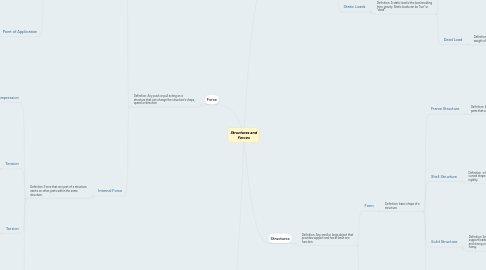
1. Force
1.1. Definition: Any push or pull acting on a structure that can change the structure's shape, speed or direction
1.1.1. External Force
1.1.1.1. Definition: Force applied to a structure from the outside
1.1.1.1.1. Gravity
1.1.1.1.2. Plane of Application
1.1.1.1.3. Point of Application
1.1.2. Internal Force
1.1.2.1. Definition: Force that one part of a structure exerts on other parts within the same structure.
1.1.2.1.1. Compression
1.1.2.1.2. Tension
1.1.2.1.3. Torsion
1.1.2.1.4. Shear
2. Sensors
2.1. Definition: Any devices that can detect or measure real world conditions such as heat, light, pressure or sound and changes in the amount of these things.
2.1.1. Example 1: Carbon dioxide sensor- It's a kind of sensor because it's a device that's can measure real world conditions, this sensor can measure the amount of carbon dioxide that's in the air.
2.1.2. Example 2:Air pollution sensor- It is also a kind of sensor because it can also detect real world conditions, this sensor can detect how serious the air got polluted.
3. Loads
3.1. Definition: A force acting on a structure
3.1.1. Dynamic Loads
3.1.1.1. Definition: A force that moves or changes while acting on a structure.
3.1.1.1.1. Example 1: Wind- wind is a dynamic load because you can't predict it it easily and also it would affect a structure from the outside just like a very strong wind can blow a tree down.
3.1.1.1.2. Example 2: Rain- rain is a dynamic load because it can affect a structure from it's outside, just like it can cause landslide when it's raining really hard.
3.1.2. Static Loads
3.1.2.1. Definition: A static load is the load resulting from gravity. Static loads can be "live" or "dead".
3.1.2.1.1. Live Load
3.1.2.1.2. Dead Load
4. Structures
4.1. Definition: Any small or large object that provides support and has at least one function.
4.1.1. Form
4.1.1.1. Definition: basic shape of a structure
4.1.1.1.1. Frame Structure
4.1.1.1.2. Shell Structure
4.1.1.1.3. Solid Structure
4.1.1.1.4. Combination Structure
4.1.2. Function
4.1.2.1. Definition: Purpose of a object or structure
4.1.2.1.1. Strength

